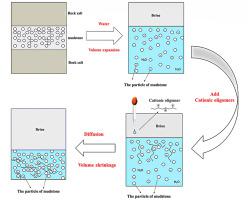Journal of Petroleum Science and Engineering ( IF 5.168 ) Pub Date : 2022-08-13 , DOI: 10.1016/j.petrol.2022.110963 Erdong Yao , Kun Zhang , Yuechun Wang , Lianqi Sheng , Zhuohan Li , Hao Bai , Fujian Zhou

|
Salt cavern gas storage takes up a high proportion of gas storage, which allows a large amount of gas production in one day and flexible market response. It has become one of the world's important strategic natural gas reserves and emergency peak-shaving facilities. However, salt cavern gas storage in China is mainly built in the layered salt formation, which is characteristic of thin salt layers with high contents of insoluble mudstone interlayers. During the construction of this type of gas storage, these insoluble interlayers can be left at the bottom of the storage and reduce the storage by 30%–70%. It is urgent to study how to effectively control the volumetric expansion of insoluble mudstones and enlarge the storage capacity. In view of this, we first characterize and quantify the rock salt, interlayer mudstones, and clay minerals by XRD. Then, 12 kinds of organic and inorganic shrinkage agents were compared in the shrinkage experiments. Five factors affecting the shrinkage are considered, including the concentration and diffusion distance of shrinkage agents, the mass ratio and particle sizes of mudstones, and the temperature. The optimal recipe and concentration of chemical agents suitable for mudstone shrinkage in salt cavern reservoir are obtained. Finally, based on the shrinking performance of mudstones, SEM scanning, EDS analysis and Zeta potential test, the shrinking mechanism of insoluble mudstones at the bottom of the cavern was proposed. The results show that: The content of swelling clay in the target gas storage is low and the clay swelling is not the main reason for the volumetric expansion of mudstones. High valence cationic salts or polymers can shrink. Among which, the order of shrinking effectiveness is: inorganic polymers > Inorganic salts > Organic polymers. When the dosage of PAC-30 is 0.7 g/L, the volumetric shrinkage effect of mudstones is more than 40%. It has a great potential to expand the storage capacity of the salt cavern. The study shows that there is an optimum dosage of the shrinkage agent. The increasing temperature and the small particle sizes of mudstones are beneficial to shrinkage. The shrinking process is a diffusion control process, and the shrinkage agents are easy to form a dense layer on the mudstone surface, which hinders the further diffusion of the shrinkage agents. Mechanism studies show that: After the addition of cationic polymer, the Zeta potential on the mudstone grain surface decreased significantly. The electrostatic repulsion between rock particles was decreased, and flocculation, agglomeration, and compaction occurred, which is the main mechanism of mudstone shrinkage in the gas storage cavern. This study provides a theoretical and practical basis for the volumetric shrinking of mudstones at bottom of bedded salt cavern gas storage.
中文翻译:

盐穴储气库泥岩收缩剂优化及收缩机理研究
盐穴储气库占储气库比重高,一天产气量大,市场反应灵活。它已成为世界重要的战略天然气储备和应急调峰设施之一。但我国盐穴储气库主要建在层状盐层,具有薄盐层、不溶性泥岩夹层含量高的特点。此类储气库建设过程中,这些不溶性夹层可留在储气库底部,减少储气量30%~70%。如何有效控制不溶性泥岩体积膨胀,扩大储量,亟待研究。有鉴于此,我们首先通过XRD对岩盐、层间泥岩和粘土矿物进行表征和量化。然后,对12种有机和无机收缩剂进行了收缩实验对比。考虑了影响收缩的五个因素,包括收缩剂的浓度和扩散距离、泥岩的质量比和粒度以及温度。得到了适合盐穴储层泥岩收缩的化学药剂的最佳配方和浓度。最后,基于泥岩的收缩性能、SEM扫描、EDS分析和Zeta电位测试,提出了洞底不溶性泥岩的收缩机理。结果表明:目标储气库膨胀粘土含量较低,粘土膨胀不是泥岩体积膨胀的主要原因。高价阳离子盐或聚合物会收缩。在这之中,收缩效果的顺序是:无机聚合物 > 无机盐 > 有机聚合物。当PAC-30的用量为0.7 g/L时,泥岩的体积收缩效应达到40%以上。它具有扩大盐穴储存能力的巨大潜力。研究表明,收缩剂存在最佳用量。温度升高和泥岩粒径小有利于收缩。收缩过程是一个扩散控制过程,收缩剂容易在泥岩表面形成致密层,阻碍收缩剂的进一步扩散。机理研究表明:添加阳离子聚合物后,泥岩颗粒表面Zeta电位明显下降。岩石颗粒之间的静电斥力减小,并发生絮凝、团聚、压实,是储气库内泥岩收缩的主要机制。该研究为层状盐穴储气库底部泥岩体积收缩提供了理论和实践依据。



























 京公网安备 11010802027423号
京公网安备 11010802027423号